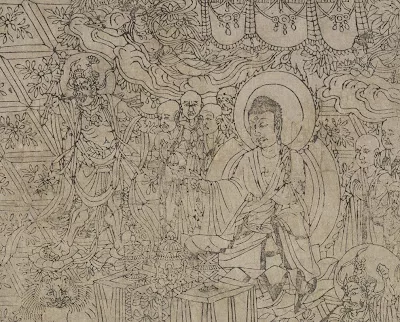Lotus Sutra Project: Storage Solutions
The Lotus Sutra Manuscripts Digitisation Project at The British Library is a multi-year project aiming to conserve and digitise almost 800 copies of the Lotus Sutra scrolls in Chinese, with a view to make images and information freely accessible on the International Dunhuang Project (IDP) website. These manuscripts come from a small cave in a Buddhist Cave complex near Dunhuang, in Northwest China, where tens of thousands of documents, paintings and artefacts dating from the late 4th to the beginning of the 11th centuries were discovered in 1900. Out of the 800 manuscripts included in this project, a large portion of them need conservation work.
Depending on the scrolls’ condition, treatment can range from surface cleaning and minor repairs, to lengthy mould remediation and intricate infills to ensure that they are safe for digitisation. With manuscripts in varying states of preservation and size, ranging from 10 centimetres to almost 14 meters in length, they have very different housing needs. Addressing these various housing requirements is part of our conservation work. We take into account our existing storage facilities, and come up with solutions that are best suited for long-term preservation of the collection but are also feasible within the time and budget of a digitisation project. This poses an interesting challenge to us as conservators.


The majority of scrolls that arrive in our conservation studio have never been treated before. They are usually tightly rolled on their own or around a thin wooden roller attached to the last panel. This causes tensions and leaves the scroll unsupported where it then becomes prone to distortions, creasing and further mechanical damage when handled. Research and practice show that the larger the rolling diameter, the less likely the scroll is to develop creases and cracks. In order to address this, we always place the scrolls on increased diameter cores after treatment has been completed. These cores are made from acid free cardboard tubes with a 5.5cm diameter, that we cover with a layer of xuan paper 宣纸 using wheat starch paste as an adhesive. The cores help reduce the tensions caused by a scroll being rolled too tightly and also provide it with proper support during handling and storage, minimising the risk of further damage. In addition, each scroll is wrapped in a protective layer of xuan paper, which prevents dust accumulation and surface abrasion.

When rolled onto the 5.5cm cores, some of the longer scrolls in the project (typically those over 10 metres long) no longer fit into the pigeon holes of our existing storage. In order to enable the scrolls to still be stored in the existing storage facilities on an increased diameter core, whilst having enough space for safe handling, we have successfully developed a technique of hand-making cores with a smaller diameter of 3.5cm, composed of archival grade kraft paper and wheat starch paste.

And what about the shortest surviving fragments? They are usually severely damaged. To prevent possible dissociation and further weakening of the paper, we encapsulate them in Melinex pockets. Melinex is an archival grade, glass-clear, thin polyester sheet, which not only helps us protect such delicate fragments but also allows them to be stored flat within custom made folders. Scroll fragments in Melinex are safe and easy to handle as both sides can be easily accessed, whether by our imaging staff during digitisation, or researchers wishing to examine the manuscripts in the reading rooms.

We are lucky that a large number of scrolls in our collection survive with their original wooden rollers still in place. In order to house the rod safely, whilst simultaneously providing appropriate support for the scroll, we have modified our standard core to create a custom-made clamp which fits the original roller inside and increases the rolling diameter. The cardboard core is cut in half; an intricate system of Japanese paper tabs is then pasted down to allow it to open and close smoothly; and, finally, a small groove is cut out to facilitate accommodating the scroll and rolling it onto the core. This clasp core design is adapted from the traditional Japanese wooden roller clamp, known as futomaki 太巻 or futomaki jiku 太卷轴, used for hanging scrolls, but is much more lightweight and economical!



In some instances, the original wooden rod is detached from the scroll, which creates another storage challenge. To avoid any dissociation, we always aim to store the rod together with the scroll. In order to achieve this, we have created small foam inserts that fit the roller in them and placed them inside standard cores. We found that polyethylene pipe insulation tubes are well-fitted for the purpose! Thanks to the Oddy tests carried by our conservation scientist Paul Garside, we know they can be safely used with our collection. The tube is cut in half and hinged on one side with Filmoplast SH cotton tape to allow for smooth opening and closing. The rod, wrapped in a protective layer of xuan paper, is placed inside and secured in place with pieces of cotton tying tape, threaded through small slits cut in the tube. The insert fits inside the core quite snugly, so we place a small tab on the bottom of the tube to facilitate access.



These storage solutions show how our work doesn’t end in the conservation studio. To ensure that the collection is well-preserved for future generations, we have to think beyond just the treatment of the object. This project has enabled us to challenge ourselves in thinking outside the box and approach the various storage issues with innovative solutions.
By Paulina Kralka, Digitisation Conservator and Marya Muzart, Digitisation Conservator, International Dunhuang Project
This article was originally posted on the British Library Collections Care blog on 07 December 2020.








If you have feedback or ideas about this post, contact us, sign in or register an account to leave a comment below